Porcelain Insulator News
by Jack H. Tod, NIA #13
Reprinted from "INSULATORS - Crown Jewels of the Wire", April 1981, page 22
Dear Jack:
I'm enclosing sketches of a couple of white
porcelain insulators I have.
I found the item with the E.S.B. CO. marking about
a year ago in a small dump by the railroad near my house, and I still can't
visualize how it would be used. Any information on it would be appreciated.
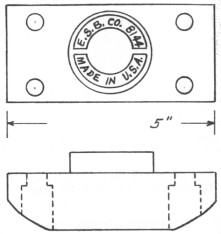
The
large wall bushing is over 4", in diameter and 12-1/4" long. It has
the IMPERIAL name on it. I found it at work in among some other Westinghouse and
unmarked ones. I imagine it was used as an exit from an indoor substation. Would
also appreciate any information as to the value of both these items.
Robert Agvirre, NIA #1846
Littleton, Colorado

- - - - - - - - -
Dear Robert:
From the marking initials,
insulator shape and location found, I'd guess the E.S.B. Co. item is an
insulating foot for a wet cell storage battery rack sold by Electric Storage
Battery Co., Philadelphia Pa., established 1888.
It's usually possible to
estimate value ranges for commonly collected items such as pin type porcelains
which are occasionally or frequently sold or traded at shows or in
advertisements. However, it's not possible for any bystander to place valuations
on any of the tens of thousands of other types of porcelain gismos used in
electrical applications and which turn up in the hands of some collector. Even
if some of these items are classed as "junk" by a majority of
collectors, they could well turn out to be "junque" if someone happens
along who is turned on by that particular item.
Jack
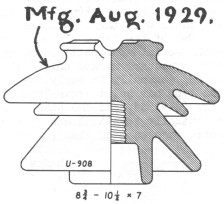
Dear Jack:
This
morning a friend drug home a baby blue U-908 "flappity-back" Insulator
just like one I have myself, but his has an underglaze inked marking (as
sketched above) on the skirt just below the side groove. By the way,
"Manufacturing" doesn't make much sense, and shouldn't it be "Mf'd"?
The insulator is made all in one piece, has a top firing surface and a metal
threads thimble -- if that will help you. Can you possibly shed some light on
this as to its manufacturer?
Brent Burger
Redmond, Wash.
- - - - - - - - - -
Dear Brent:
If a
bird looks like a duck, waddles like a duck and quacks like a duck, it's more
than likely a duck. Jeffery-Dewitt made and cataloged the U-908, used light blue
glaze on all their HV insulators and stamped the manufacturing date on them, so
you more than likely have a J-D insulator.
The light blue glaze was a J-D
hallmark on all pin types and suspensions over 23 Kv rating, and it was known as
simply "J-D Blue" throughout the industry. Their standard glaze was
brown on pin types 23 Kv and smaller.
I believe all the J-D date stampings I've
seen have been with "Mfg." just as yours, so that must have made
better sense to them than it does to you and me.
J-D made all their suspension
disks and large pin types by casting (the only company to do that), so
cemented-in metal threads thimbles are par for the course on ones such as yours.
Due to this manufacturing process, the company also won the prize for the
largest unipart pin type ever made -- their gigantic #66 (U-914) made in the
1930's.
Incidentally, all this info about J-D insulators is in your copy of
"Porcelain Insulators Guide Book". Miss it?
Jack

Dear Jack:
A
power line was constructed around the turn of the century from the Pioneer hydro
plant in Ogden towards Salt Lake City, Utah. At one time, it was said to be the
longest distribution line in the country. I have insulators taken off this old
line near Ogden, and there were three varieties.
Two of the types are white ones
with two interior petticoats, and both types are marked only with dates,
generally in early 1897. One type has split crown lugs on each side (U-935A),
and the other one is essentially identical except for large solid lugs on each
side (U-935B).
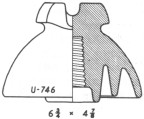
The other type (U-746) have various shades of brown glaze. They
mostly have a lot of markings, but the heavy glaze over the small letters of the
markings makes reading the markings difficult on the ones I've seen. I have been
able to make out the name NEW LEXINGTON on some. On others I've seen the word
MARK and also N.J. which I believe would be for New Jersey, plus a full date.
The dates are illegible, but I think the year is 1897.
Any information you can
give me on these insulators would be appreciated -- their origin, value, U-
number.
Steven G. Nelson
4275 S. 1050 West
Ogden, Utah 84403
- - - - - - - - - -
Dear Steven:
Your
4-eared cables are U-935A, and we've attributed these to Imperial Porcelain in
the past, due to their general style and the 1897 manufacturing dates made with
the same stamping device found on other Imperials of that era.
The similar item
with single wide ears on each side is U-935B, and we reported this on page 31
of the October 1978 CJ issue. Both these styles by Imperial evidently have been
found in the Utah area only, and they are relatively scarce in collector circles
thus far.
The brown ones are U-746 and evidently are by two separate
manufacturers. The ones with NEW LEXINGTON marking are by New Lexington High
Voltage Porcelain Co. (Ohio), and any unipart pin types with this marking are
rare.
The other brown ones are Imperials with their typical markings -- the crown
trade mark, the address marking, the manufacturing date. The 1897 date doesn't
sound logical for these, since most brown Imperials bear dates well after 1900,
and I think the U-746 "Redlands" style originated after 1897. Also,
New Lexington wasn't established until 1903.
I can't accurately estimate
values on these, but both the white ones are "goodies" -- maybe in the
$25 to $50 range. The brown ones would be fairly good items with clear Imperial
markings, even better with New Lexington marking. But their desirability (and
value) would be diminished with fuzzy to poor markings, and greatly reduced if
the markings were completely indiscernible.
Jack
Dear Jack:
(NIA #41)
I recently
acquired a few Fred Locke insulators that I thought may be of interest to you
and people specializing in the early Locke items. (Elton Gish, Port Neches,
Texas)
- [My comments are inset after each item below. Jack]
U-923 but without the
incuse #2-1 Fred Locke marking in the top cross-groove. Instead, it has an
incuse #3-1 marking stamped on the skirt -- the marking "Manufactured for F.
M. LOCKE / Victor, N.Y. of Imperial Porcelain / ... etc." The wording is
identical with the similar underglaze marking known, but the punctuation in it
is quite different.
- [I think this specimen must be one of the very first ones of
this style made by Imperial for Fred Locke, I've not heard of it before, and
it's undoubtedly a rare variety. The ordinary U-923's were also made by
Imperial, but they have the Fred Locke groove marking plus the common Imperial
#1 marking on the bottom of the skirt.]
U-608 and U-611, both in white! Are these
very common with white glaze?
- [No, and I can't recall for certain of ever
having seen either of these styles in white.]
U-648, white, marking stamp #1-8,
pressed in a two-piece mold, very crude. An accompanying porcelain-base pin with
white glaze has marking #1-3 but with reversed "D" in FRED.
- [Yes, some
of the U-648 and early Fred Locke Roman Helmet insulators were obviously pressed
and jiggered in parting-type molds, but this was not ordinary practice at
Victor, and I think any of these items with "mold lines" were most
probably made in about 1898 or 1899 at the very latest -- at the Victor plant.]
U-330A, very shiny butterscotch, marking #0-3, in pristine mint condition. Looks
like it was never used.
- [A very rare item, but don't count on it being an
"unused" one by its pristineness. Anyone who ever cleaned dirty
specimens with a quick dip in our MIG-19 cleaner (no longer sold) would agree
that it made impossibly dirty specimens look like real virgins in short order.]
U-926A, dark tan, marking #7-1. Have you ever heard of any Fred Locke's with the
#7-1 marking other than my large 3-piece multi shown on page 52 of Gerald's Fred
Locke book?
- [I've never systematically tried to record which Fred Locke marking
stamps were known on different styles of his insulators, so I can't help you
there. Jack]
Dear Jack:
... and do you know how come Pony insulators are called
"ponies"?
Gerald Brown, NIA #73
Two Buttes, Colorado
- - - - - - - - -
Dear Gerald:
Well, I'll consider telling you, but only for a price. You have to tell me where
they got the name "Emily Knob" for the large screw-eye insulator
listed in electrical jobber catalogs. See page 58 of my book "Electrical
Porcelain".
The unabridged Webster's gives one definition of pony as,
"in general, a designatory, term for something smaller than the average for
its kind". In another edition, "something smaller than standard",
and they give examples. I went to my big 24-volume encyclopedia to get a more
detailed answer, but it wasn't very helpful when their entire definition
consisted of only, "See horse".
As related to electrical items, a few
illustrations would be pony socket, pony telegraph report, pony insulator.
In
chicken-before-the-egg theory, it figures there were small species of horses way
back when the most advanced manufactured item was a club or spear point, so the
small horses were named ponies. Centuries later the connotation was then applied
to other "things" substandard in size, and thus the origin of the word
as an adjective. If it weren't so, you would hear the redundancy of "pony
horse," for a small horse. But if you complain that you've heard that when
down in Tennessee, don't forget they also call birds "pecker woods".
Hope I didn't confuse you, Gerald. If a cute young gal comes up to you and asks
you how you like her pony tail, careful there -- that's a horse of a different
color.
Jack
Dear Jack:
I am enclosing several photos of some old strain
insulators I've acquired. The wooden strains I have were found on the outside of
the car barn of the old Utah Idaho Central (d.c.) Railroad ....
Any information
you can give would be greatly appreciated. If you can't help on this, maybe you
can refer me to someone with knowledge on them. I have extras of some of the
types which will later be for sale or trade ....
Steven Nelson
Ogden, Utah
(Steven gave a two-page description of the one wooden and five different
composition items -- their markings the colors of the variously green, reddish or
silvery mica-type composition material used. One nice photo showing four of the
styles is shown below. JT)
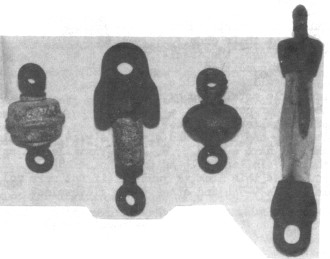
- - - - - - - - -
Dear Steven:
I can't attribute with certainty all of
the old composition strain insulators in your photos. For years I've suggested
that the non-glass and non-porcelain insulators would provide an interesting and
exciting field for research for some collector looking for such a worthwhile
pursuit. Evidently no one has yet taken the opportunity to mine this untapped
field and publish data which would be of immense value to all collectors.
What
information we do have on these items is very widely scattered among a number of
collectors. The one comprehensive reference on these types of insulators, and a
valuable addition to any collector's library, is Gerald Brown's "Unique
Collectible Insulators" (from him, $4 -- practically a free gift at today's
prices).
The wooden ones such as yours were made by Westinghouse. Composition
ones were made by Johns-Manville, Electrose Mfg. Co., Albert & J. M.
Anderson Mfg. Go., Westinghouse, Ohio Brass Co., American Insulator Co. and Shaw
Insulator Co. I think most of the composition strain types in your photos are
Ohio Brass Co. items.
Jack
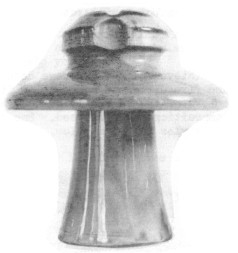
Dear Jack:
Enclosed is a photo of the largest
glazeweld style I've run across. It's unmarked, a light butterscotch with some
darker banding at the various edge points. Note the tiny top groove for an
insulator so large (8" skirt, 8-3/8" tall). The thing is of rather
dainty construction, the skirts being only 1/4" thick at their ends.
Surprisingly though, the insulator is in mint condition.
Can you recall seeing
this particular style catalogued by any of the larger porcelain companies? I
believe you once said both Locke and Thomas had similar styles, so could this be
a Locke? I have a 1905 H. W. Johns-Manville Co. catalogue, and it shows a
similar style as their No. 8 "S".
Do you agree this item is just as
(if not more so) desirable as the U-944 and other early glazewelds?
Ray Klingensmith, NIA #1654
East Orwell, Ohio
- - - - - - - - - -
Dear Ray:
It's not possible with our
present knowledge to attribute with certainty these early unmarked glazewelds,
but we can make some educated guesses on some of them. A number of companies
made two and three-part glazewelds such as this one, plus even much larger ones,
so that's no help. Some companies persisted with optional glazeweld construction
of two-piecers up to about 1920.
All these larger, long-skirted glazeweld styles
are either rare or unknown now. I'm certain they were in quite common usage in
their days of manufacture, but they were just pitched in dumps as lines were
reinsulated in later years. I doubt that any of these styles or the proverbial
lilly-shells survived on lines beyond the mid-1930's. Ones still extant are
those like yours which were merely pretty ceramics and made nice house
ornaments.
Some of the early catalogs pictured insulators only with fuzzy
artists' sketches instead of mechanical drawings. I made drawings of those where
it was possible and put them in the Universal Style Chart. But I also showed
best-can-do drawings of 32 other early styles in the July 1973 CJ column, all
yet unseen then by collectors, and including a number of the larger
multi-skirted glazewelds.
Your specimen is obviously a new addition to the U-
Chart and would logically fit best at about the U-967 spot.
This is probably not
a Locke because it's unmarked, the glaze isn't typical for Locke, the crown
shape doesn't agree with Locke practice, and Locke didn't catalog this style as
a glazeweld.
It could be a Thomas because of the crown style, but the glaze just
doesn't "smell" right for Thomas insulators.
Although we know
relatively little about New Lexington H.V. Porcelain Co., we do have some of
their catalogs, a few marked insulator specimens, plus shards I located near the
defunct plant site in Ohio, The crown style, dainty skirts, absence of marking
and the glaze type all fit. If I were forced to place a bet, I'd put my chips on
that square.
I too have Johns-Manville catalogs, from their earliest ones to the
time they quit selling insulators. Their porcelains were either Thomas or New
Lexington, and you can go through the J-M list against other catalogs and pick
them all out as to manufacturer. In the earlier J-M catalogs, they used Thomas
catalogings: verbatim -- the same numbers, data and photo cuts. Incidentally, I
found shards of two enormous pin types at the N.L. plant site which bore the J-M
marking.
This item is probably not in the same value class as the distinctive
U-944 Thomas, since comparable later-vintage multiparts are common. But its
classic early styling and its large size for a glazeweld does make it a real
goody. If it had a New Lexington or Johns-Manville marking on it, you could name
your own price!
Jack

Many thanks to Wayne Junop (Ontario, Canada) for sending
catalog sheets showing insulators of the Dalian (China) Insulator Works of the
China Nat'l Machinery & Equipment Corp. The insulators pictured generally
are identical to the American Nat'l Standard (ANSI) styles. Actual photos in the
brochures show clearly the A insulators are marked with the logo shown here plus
some numbers and Chinese characters.
Regarding the patented metal
protective shield for insulator skirts shown on page 15 of the Feb 1981 column,
Don Fiene (Knoxville. TN) wrote to say that he got one of these at the
Louisville flea market about 10 years ago. The shield is made of iron and
attached to a Hemingray-42 It's still whole but too rusted to be removed.
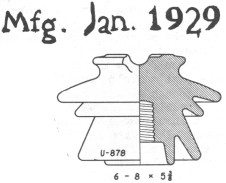
Dear
Jack:
As you can see from the address, we live in Florida now and hope it's
permanent. But this is the worst area for insulator hunting. It is odd to find a
telegraph pole, let alone an insulator!! The local railroads have several poles
up at street intersections, but that's it. I've scouted some antique stores, and
I think I've come up with a wierd find -- and hopefully worth the $20 I paid for
it.
I've enclosed a sketch of this large power insulator, and also the marking
"Mfg. Jan. 1929" which is underglaze on the top of one crown ear. The
insulator glaze is a deep sky blue with a lot of very dark blue (cobalt) areas
in it -- especially at all the various edges and grooves, plus the complete
undersides of each skirt ....
Would appreciate any info ....
Ken Crawford
St.
Petersburg, Fla.
- - - - - - - - - -
(J-D-itis this month. See also Brent Burger letter.)
Dear Ken:
Your insulator was made by Jeffery-Dewitt ....
I think $20 might be an the high
side for normal unmarked J-D two-skirters, but it's probably o.k. on this
specimen with the manufacturing date and the exceptional dark blue banding and
underparts. Sure sounds like a pretty thing. Exact probable value should be of
concern mainly to anyone buying things for resale or investment. When someone
buys something just because he wants it himself, it's worth whatever he paid for
it. At today's prices, you can eat a hotdog some night instead of going out to a
restaurant, and then consider your insulator as a free gift! Really though, I
think you got a fairly good buy on it.
Jack
| 